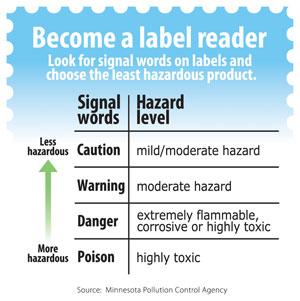 Protect yourself and your family. Read the label.
Protect yourself and your family. Read the label.
The label should tell you what the product is for, how to use it, the hazards you can be exposed to, and what to do if you have an accident.
It is important that you read the label before you buy a product. Many injuries and unsafe exposures can be avoided by reading the label. You are in the store looking for chemicals because you have a job to do at home or at the office. Maybe you have a drain that is backed up, or just need some window cleaner. How do you decide which of the many products on the shelf is best for you? Start by reading the labels.
How to read the label
What is this product for?
- Does it do just one job, or can I use it for several tasks?
- Are there any restrictions, such as “avoid using product around plastic, metal or fabric?”
How do I use it?
- Is the product ready-to-use, or do I mix it with water?
- How can I mix the product safely?
- How much will I need to do the job?
How hazardous is the product?
- Read the product label to determine what types of hazards you face and how to protect yourself.
- Can the product burn your skin?
- Can it catch on fire?
- Should you use it outside?
- Should you wear protective gloves, goggles, a breathing mask or other equipment to prevent being exposed?
- All chemical pose some risk, so know what you are getting into.
What do I do if I have an accident?
- Does the label say what to do if the product contacts skin, or is inhaled or swallowed?
- Does the label give you enough information to prepare for and respond to these accidents?
Choose the right products
Choose products with labels that say:
- Non-Toxic: touching, breathing or accidentally drinking the product will not kill you (although you may get sick).
- Biodegradable: Natural bacteria in the environment will convert the product into harmless chemicals,
- Contains No Hazardous Ingredients: This phrase usually means that the product does not contain more than 1% of any single hazardous chemical or 0.1% of any single carcinogen.
Other phrases that may help identify safer products include:
- Free of chlorine
- Water based
- No dye or perfume
- Citrus based
Choose products with label statements such as:
- Non-toxic
- Non-carcinogenic
- Non-petroleum based
- Free of ammonia, phosphates, dye, or perfume
- Readily biodegradable
- Non-fuming
- Recyclable container
Be aware that phrases like “eco-friendly”, “green,” and “environmentally preferable” can be misleading.
Check out recipes for green, safe cleaners for your home.
Products to avoid!
- Where possible, avoid products having labels that say any of the following signal words: Caution, Warning, Danger, or Poison
- Danger hierarchy: Choose products labeled “Caution” over “Warning;” avoid products labeled “Danger” or “Poison”
Definitions:
- Poison, Danger or Highly Toxic – Swallowing 1 teaspoon or less can kill a person.
- Warning or Very Toxic – Swallowing 1 teaspoon to 1 tablespoon can kill a person.
- Caution or Toxic – Swallowing an ounce to a pint can kill a person.
- Corrosive or Caustic – Contains chemicals that can blind you or burn your skin.
- Flammable or Combustible – The product will burn easily, and may give off vapors that can ignite.
- Explosive – The product or container could explode if mishandled.
- Volatile or Contains VOCs – Contains volatile organic chemicals (VOCs) that evaporate and cause air pollution and potential health effects.
- Provide Adequate Ventilation – Lots of fresh air is needed to keep you from breathing harmful amounts of the product or to prevent explosion.
- Contains Propane or Contents Under Pressure – These are aerosol containers, which cost taxpayers more to dispose of and have more risk than do the same products that are packaged in pump spray bottles.
Other tips that a product is toxic include:
- Harmful or fatal if swallowed
- Instructions that call for use of safety equipment
- Warnings of environmental hazards (like toxic to bees, birds and fish)
